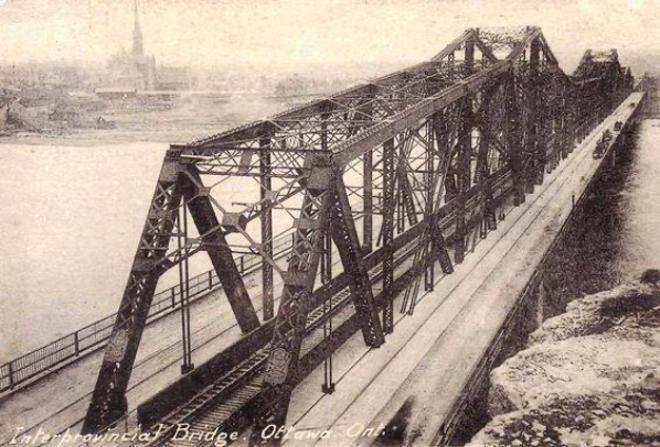The Alexandra or Interprovincial Bridge: A Brief History
HERITAGE OTTAWA, by David Jeanes
An interprovincial bridge at Nepean Point was first proposed by J.R. Booth when his Canada Atlantic Railway reached Rideau Street in 1896. However, it was Horace J. Beemer, another railway entrepreneur, president of two Ottawa area railways and contractor in 1880 for stonework of the Prince of Wales Bridge, who arranged financing and construction of the bridge. The federal government contributed a $112,500 subsidy, Ontario $50,000 and the City of Ottawa $150,000, on condition that the bridge include roadways as well as the railway. When opened in 1901, the bridge had a railway, two pedestrian walkways and two road decks, with streetcar tracks for the Hull Electric Railway to reach Dufferin Bridge.
Dominion Bridge of Lachine, Quebec, erected the pin-connected steel trusses in 10 months in 1900. Twelve years earlier they had built one of Canada's first cantilever bridges at Lachine for the Canadian Pacific Railway and a conventional multi-span bridge at Coteau for Booth's Canada Atlantic Railway, both crossing the St. Lawrence. In 1916 Dominion Bridge would complete the Quebec Bridge, the world's longest cantilever span. They became a major Ottawa player for the steel framework of bridges, hotels, high-rise offices and exhibition buildings with a fabrication plant in Eastview (now Vanier).
Cantilever bridges were introduced in the United States in 1877 and Canada in 1883, to span gorges and rivers that were too deep, wide or fast-flowing for temporary falsework during construction. Ottawa additionally had a mountain of accumulated sawdust at mid-river, requiring a very wide spacing of the main piers. Six piers were constructed of concrete and limestone in 1898 and 1899, using the novel technique of concrete that set under water. The deepest pier was in 68 feet of water and the government stopped construction for six months until the concrete was proved sound. With its limestone cap, this pier was 99 feet high.
The pin-connected steel bridge had one short truss and five truss sections of nearly identical 247-foot length. Three sections were assembled on floating scows for temporary support, beginning on the Hull side, where steel could be delivered by rail. The partly-assembled third section was floated across the river in April 1900 and placed on the piers at Nepean Point. The last two sections were built unsupported, using the cantilever technique in which the shore span balances the river span. When joined at mid-river, it was the world's fourth longest cantilever span at 555 feet 9 inches, after bridges in Scotland, the United States and Hungary.
The name "Alexandra" was proposed by Ottawa mayor W.D. Morris in 1901, when Queen Alexandra's son, the Duke of Cornwall and York, (later King George V), visited Ottawa. Horace Beemer put "Royal Alexandra" in lights on the bridge, but the "Royal" designation had not been approved and there was no official naming ceremony, even though the royal party did cross the bridge. Beemer intended the lighted name to be switched on remotely by the Duke when he unveiled Queen Victoria's statue; the lights can be seen in photographs of this event. So it continued to be known as the "Interprovincial" but also as the "Alexandra" Bridge.
The bridge carried Canadian Pacific transcontinental trains between Montreal and Vancouver from 1902 to 1966 and Hull Electric Railway streetcars from 1901 to 1946, when a major fire at E.B. Eddy damaged the Hull end of the Bridge. The National Capital Commission acquired the bridge from the C.P.R. after the 1966 closure of Union Station. The rails were replaced by a roadway and one road deck became a pedestrian and cycling boardwalk. The Canadian Society for Civil Engineering designated it a National Historic Civil Engineering Site in 1995. A celebration on 21 April 2001 of the centenary of the first train saw an STO bus with destination sign "Interprovincial 100" bring dignitaries from Gatineau to join politicians, engineers and railway heritage groups for a celebration at the Ottawa end of the bridge.
Concerns about the condition of the bridge led to a major rehabilitation in 2009-2011 and replacement of the central road deck. More work is under way at present to repair corroded steelwork, piers and pedestrian-cycling deck. The bridge has an iconic presence in views of the Ottawa River, Parliamentary Precinct, Rideau Canal World Heritage Site, Nepean Point and Canadian Museum of History. It is an integral part of Confederation Boulevard. Although it carries only 9% of cross-river road traffic, it is the busiest Ottawa-Gatineau pedestrian and cycling link.
In May 2020, the federal government revealed plans to replace the iconic 120-year old Alexandra / Interprovincial Bridge. A serious flaw discovered during inspection required an unplanned closure of the bridge to vehicles in May for urgent repairs and further such closures have followed. Although the bridge could be safely maintained for six to ten years, a 75-year rehabilitation was not considered cost effective, compared to replacement by a new bridge. Public Services and Procurement Canada and the National Capital Commission began stakeholder and public consultations in October and November.
The Alexandra Bridge Coalition proposes that the Bridge be retained for its national built-heritage value and significance, and repurposed for green infrastructure transportation.
David Jeanes is a member of the Board of Heritage Ottawa and Action Transport Canada.
This article appeared in the March-April 2021 issue of the Heritage Ottawa Newsletter.
